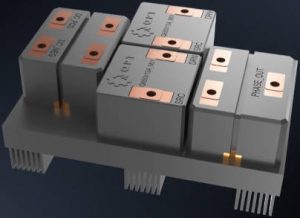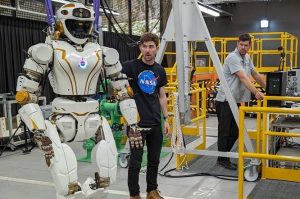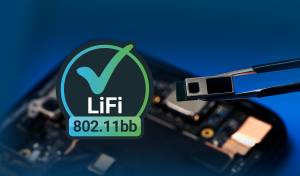What are the topics covered? There’s GaN Systems signing a MOU with QPT, Intel launching the Catalyze partnership programme, Nasa’s humanoid robot, the 2030 date for banning the sale of new ICE vehicles, and the LiFi standard, IEEE 802.11bb….
 5. GaN Systems signs MOU with Cambridge power module design start-up
5. GaN Systems signs MOU with Cambridge power module design start-up
Transistor maker GaN Systems has signed a memorandum of understanding with QPT, a start-up with patents covering power modules designed using RF techniques to get the best out GaN transistors. The MOU covers the use of QPT technology and GaN Systems transistors in electric vehicle power converters – in particular: 100kHz to 20MHz hard-switching high-power and high-voltage converters. “We are impressed with the technologies that QPT has developed,” said GaN Systems’ CEO Jim Witham. “They have unlocked functional improvement in performance.”
4. Schneider Electric, Intel and Applied launch Catalyze
Yesterday, Schneider Electric, supported by Intel and Applied Materials, launched Catalyze, a partnership programme aimed at accelerating access to renewable energy across the global semiconductor value chain. Intel and Applied are the inaugural corporate sponsors of the Catalyze programme and will, together with Schneider Electric, encourage suppliers from throughout the semiconductor industry ecosystem to join the Catalyze programme and help accelerate the value chain’s transition to renewable energy and a low carbon future.
 3. NASA Valkyrie humanoid robot heads for testing in Australia
3. NASA Valkyrie humanoid robot heads for testing in Australia
G’day humanoid robot. Nasa is sending its robotic system, dubbed Valkyrie, down under to complete its testing, with the energy company Woodside Energy in Perth, Western Australia. It is part of a research-sharing Space Act Agreement, explains the space agency, which plans to use a Valkyrie robot to develop remote mobile dexterous manipulation capabilities, for remote caretaking of uncrewed and offshore energy facilities. Woodside Energy will test the resulting software and provide data and feedback to NASA.
2. The ICE Age [Mannerisms]
There are many reasons for postponing the 2030 date for banning the sale of new ICE vehicles but one of the more compelling is that, sometime between 2000 and 2035, solid state batteries are likely to enter volume production and boost EV range by 2-3X. According to a report called “Development of Solid-State Batteries for NEVs” by TrendForce, the Nickel Cobalt Manganese (NCM) based versions of lithium batteries have a 500-600 km range and Lithium Iron Phosphate (LFP) based versions have a 300-500 km range while ICE has a 600-1200 km range.
 1. LiFi standard released – IEEE 802.11bb
1. LiFi standard released – IEEE 802.11bb
A standard for LiFi has been released – IEEE 802.11bb. By harnessing the light spectrum, LiFi can deliver faster, more reliable and more secure wireless communications compared to WiFi and 5G. The Light Communications 802.11bb Task Group was formed in 2018 chaired by pureLiFi and supported by Fraunhofer HHI. Both organisations aim to see accelerated adoption and interoperability not only between LiFi vendors but also with WiFi technologies as a result of these standardisation efforts.




